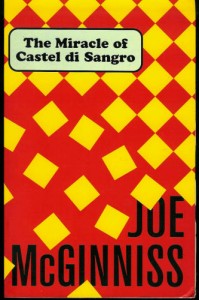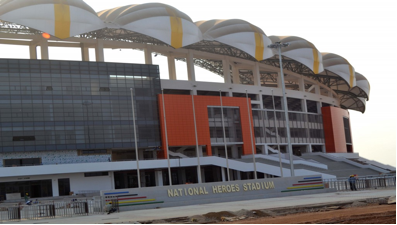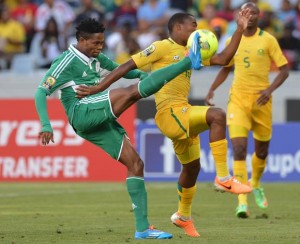 Joe McGinniss had a love affair with soccer.
Joe McGinniss had a love affair with soccer.
The award-winning author and journalist died on March 10, 2014, of prostate cancer at the age of 71 (read an obituary here). I got to know Joe pretty well in the late 1990s while he was writing The Miracle of Castel di Sangro, one of the very first commercially viable books written by an American member of the soccerati class.
I was working on my PhD in African history at Boston University at the time and also teaching a course on “Soccer and Imperialism” at Tufts University. My mother had sent me a Corriere della Sera article about Joe chronicling Castel di Sangro’s 1996-97 serie B season for a David-versus-Goliath book about the team from an Apennine town of 5,000 souls competing just one tier below serie A, then the best league in the world.
As a fútbologist born and raised in Rome, I was naturally intrigued. So I wrote him a concise letter introducing myself and suggesting that given our shared love of calcio it would be nice to meet some time in the near future. Next thing I know Joe got in touch and we met at a Legal Seafoods at Boston’s Logan Airport. He was about to fly back to Italy for what would turn out to be an unexpectedly eventful end to his season in Castel di Sangro.
After the usual pleasantries the talk immediately turned to Italy, football, and especially Roberto Baggio. We reminisced about Baggio’s transcendental play at the 1994 World Cup, which we both witnessed in person at Foxboro stadium and at the Meadowlands. The Divine Ponytail—and an interview with Alexi Lalas then at serie A minnows Padova—inspired the football-naive Joe to embark on the project that became Miracle. “I was enthralled,” he explained in the book. “Now my obsession had a focal point, Baggio brought to the game a degree of elegance, a grace, and an aura of magic that I’d not before seen displayed in any sport” (The Miracle of Castel di Sangro, p. 22).
Joe’s Italian was humorously choppy and football knowledge limited, but it was hard not to like his passion for the game, his curiosity, and affable nature. I was impressed by Joe’s unwavering commitment to tell the improbable story of the football club from Castel di Sangro.

As it happened, I spent the following year on a Fulbright scholarship doing my PhD research in South Africa while Joe completed his book manuscript at home in western Massachusetts. We corresponded regularly via email. After a long day in the archives, I remember looking forward to reading Joe’s electronic cocktail of chapter drafts, praises of Baggio’s stellar performances with Bologna (22 goals in 1997-98), and polemics about Gazzetta dello Sport player ratings. I appreciated how an author whose books had graced the New York Times bestseller lists seemed to value both my feedback on his work and my tales of playing football and researching the social and political history of the game in South Africa.
I translated for Joe portions of the Italian edition of Eduardo Galeano’s Soccer in Sun and Shadow. By the time the English edition came out a couple of years later, the Uruguayan author had already taken his place next to Robi Baggio in Joe’s pantheon of football gods. The epigraph in Miracle reflects this conversion and beautifully captures Joe McGinniss’s deep love for the game: “Years have gone by and I’ve finally learned to accept myself for who I am: a beggar for good football. I go about the world, hand outstretched, and in the stadiums I plead: ‘A pretty move, for the love of God.’ And when good football happens, I give thanks for the miracle and I don’t give a damn which team or country performs it.”
The latest Cowries and Rice podcast features Michigan State University History PhD candidate Hikabwa Decius Chipande discussing China’s stadium diplomacy in Zambia. Intriguingly, the enterprising hosts of the podcast, Winslow Robertson and Dr. Nkemjika Kalu, contacted Chipande in Lusaka after reading his “China’s Stadium Diplomacy: A Zambian Perspective” post on this blog.
In the interview (listen above), Chipande expands on his original contribution to explore several key aspects of the national and international politics of stadium construction in contemporary Zambia. Chipande shares his expert view on Zambian responses to the new arenas, inspired by Elliot Ross’s recent essay on the topic for Roads & Kingdoms, and contextualizes them within larger Chinese investments in mining and other sectors of the economy in south-central Africa.
Chipande is a recipient of the FIFA Havelange Research Scholarship for his doctoral dissertation on the social and political history of football in Zambia, 1950-1993. Reach out to him on Twitter at @HikabwaChipande.
Goal Kolkata
Celtic-Rangers. Liverpool-Everton. Roma-Lazio. Boca-River. Fla-Flu. Kaizer Chiefs-Orlando Pirates. Mohun Bagan-East Bengal. Wait, what was that last one?
Mohun Bagan vs. East Bengal is “one of the greatest, and most overlooked, football rivalries in the world,” says Kelly Candaele, director of Goal Kolkata, a documentary film set to explore the history and culture of a highly charged Indian rivalry. The film tracks players, team officials, and fans of both teams before, during, and after a recent derby played in front of 120,000 spectators at Salt Lake Stadium in Kolkata (Calcutta).
The new trailer (see above) features new footage and interviews filmed in November 2013. It includes important interventions by Indian sport scholars, such as Kausik Bandopadhyay (West Bengal State University) and Boria Majumdar (University of Central Lancashire), who flesh out the origins of the rivalry and shed light on its larger social, political, and economic significance.
Goal Kolkata promises to teach us much about football culture in India while also engaging with broader Bengali and Indian history. For more information about the film and ways you can help support its completion, go here.
South African Goals of the Season, 2011-13
Goals galore from South Africa, courtesy of MattMzansi’s YouTube channel. Because you can’t win if you don’t score.
Futebol Nation: The Story of Brazil
The Garrincha of futbology, David Goldblatt, admits he’s neither Brazilian nor a Brazilianist as he begins his recent public lecture at Pitzer College in California.
Then, like Garrincha, he feigns left, goes right through through Brazil’s World Cup history, pivots on slavery, Lusotropicalism and GINI coefficients, does a give-and-go with Mario Filho, dribbles around Benedict Anderson, reaches the Maracanazo touchline, and delivers a cross into the Vinegar Revolt of 2013.
Eduardo Galeano has written that “in the history of soccer no one made more people happy” than Garrincha. It’s not too much of a stretch to say that in the field of futbology the same is true for David Goldblatt.

Guest Post by *Hikabwa Chipande
“If you want to see the heart of China’s soft-power push into Africa,” writes Elliot Ross in a recent piece for Sports Illustrated’s “Roads & Kingdoms” series, “you’ll find it in the continent’s new soccer stadia.”
I am one of the many Zambians saddened that most of our national team matches are now staged at the Chinese-built Levy Mwanawasa Stadium in Ndola, an industrial town on the Copperbelt 200 miles north of the capital, Lusaka. This is not only because I live in Lusaka, where the team used to play its home games, but also because the move greatly diminishes, if not erases, the deeper significance of historic football venues.
It was in Lusaka’s then-newly constructed Independence Stadium on October 23, 1964, that the Union Jack was lowered and the new Zambian flag raised at midnight in a sumptuous ceremony attended by the Princess Royal and Kenneth Kaunda’s new cabinet. The following day, the stadium hosted the final of the Ufulu (independence) tournament. Ghana’s Black Stars, reigning African champions, beat Zambia 3-2 in front of about 18.000 spectators. From then on, almost all important international matches (as well as domestic cup finals) were played at Independence Stadium, a local example of how stadiums in postcolonial Africa, “quickly became almost sacred ground for the creation and performance of national identities” (Alegi, African Soccerscapes, p. 55).
Occasionally, Dag Hammarskjöld Stadium in Ndola hosted big matches. Constructed by the Ndola Playing Fields Association during the colonial era, this ground was rechristened in honor of the Swedish Secretary-General of the United Nations, Dag Hammarskjöld, who died in 1961 in a plane crash near Ndola. After the British colony of Northern Rhodesia became independent Zambia, the stadium was donated to the Ndola City Council. As the largest stadium in the Copperbelt, the traditional hub of football in the country, it hosted virtually every important match in the region.
In January 1986, the Zambian government bought into the idea of hosting the 1988 African Nations Cup finals. Mary Fulano, then a member of the Central Committee in charge of sport, informed the public that the government had started renovating both Independence and Dag Hammarskjöld stadiums. But in December 1986, after Dag Hammarskjöld stadium had been demolished for its planned reconstruction, Youth and Sport minister Frederick Hapunda announced that government had withdrawn its bid to host the 1988 tournament.
Copperbelt residents complained that they needed their beloved stadium, but the government kept on issuing empty promises. Surprisingly, two decades later, when an opportunity arose to build a new stadium in Ndola courtesy of China, the Zambian government opted for a completely new Levy Mwanawasa Stadium in a different area, thereby burying the rich history of Dag Hammarskjöld Stadium.
In 2012, I attended the inauguration of the Levy Mwanawasa Stadium: a 2014 World Cup qualifier between Zambia and Ghana (see my blog post about it here). The atmosphere at the venue was similar to the one described by Elliot Ross at the Estádio Nacional do Zimpeto in Maputo. Unlike the game in Maputo, however, there was no pushing and shoving at Levy Mwanawasa, thanks to plenty of available space and sound event management. But the stadium was so vast that the crowd could not sing and chant cohesively, or create the electrifying atmosphere so many of us treasure at football grounds.
The ignominuous end for Independence Stadium in Lusaka came after FIFA inspectors in 2007 declared it unsafe for international matches. As a temporary solution, the Football Association of Zambia moved internationals to Nkonkola Stadium in a small mining town on the border with the Democratic Republic of Congo. Bolstered by another Chinese loan, the Zambian government then erected a new National Heroes Stadium directly across from Independence Stadium and the graves of national team members who perished in the Gabon air crash of 1993.
The demolition of Independence Stadium prompted many people to wonder why the government chose not to renovate the hallowed ground and build the Chinese-funded stadium somewhere else in Lusaka. While younger Zambians tend to like the new sporting arenas, many older fans lament the disappearance of stadiums they associate with the stories of their personal lives, their memory, their past.
Regardless of age and status, Zambians are very much aware of “Chinese soft diplomacy.” People know that Chinese stadiums have less to do with friendship or mutual cooperation and more with gaining access to Africa’s material resources. Yet there is very little that can be done about it because the government does not consult with citizens on economic deals with China. There is criticism about Chinese firms bringing very cheap laborers to work in construction sites. But there seems to be a general feeling among the population that it is acceptable for the Chinese to build stadiums and other infrastructure in exchange for copper because the alternative is allowing Zambia’s political leaders to pocket the profits from this wealth.
—
*Hikabwa Chipande is a PhD candidate in History at Michigan State University. He is a recipient of the FIFA Havelange Research Scholarship for his doctoral dissertation on the social and political history of football in Zambia, 1950-1993. Follow him on Twitter at @HikabwaChipande
 Guest Post by Liz Timbs (@tizlimbs)
Guest Post by Liz Timbs (@tizlimbs)
“We indeed have a crisis of monumental proportions. We don’t have a crisis of talent, we have a crisis of putting everything together,” thundered South African Sport and Recreation Minister Fikile Mbalula following South Africa’s 3-1 loss to Nigeria in Cape Town on Sunday, which eliminated the hosts from the 2014 African Nations Championship.
Mbalula publicly lambasted the national team, declaring that what he witnessed “was not a problem of coaching, it was a bunch of losers.” This “bunch of losers” and “unbearable useless individuals,” Mbalula continued, humiliated their country: “In Africa we have won nothing—we are the laughing stock. Even Madiba Magic would not have worked. This generation of players we must forget.”
Danny Jordaan, president of the South African Football Association and ex-CEO of the 2010 World Cup Local Organizing Committee, also criticized Bafana’s performance in the media, though in slightly less forceful terms than Mbalula. Jordaan saw the team’s elimination as an embarrassment, noting that SAFA had been “dismissive and even insulting to the quality of football on the continent.” He highlighted a deficiency in the “preparations, philosophy and technical staff.”
The reaction from Bafana Bafana head coach, Gordon Igesund, was decidedly tamer. “There are no excuses,” Igesund declared, “We lost to a better side . . . at the end of the day we have to look at ourselves and admit we were just not good enough even though we gave it our best shot.” Midfielder Siphiwe Tshabalala echoed Igesund’s understated honesty in his comments to the press. He apologized for the team’s debacle, adding that: “we are hurting and we know the nation is also hurting and we are not proud of not doing well but we just have to apply ourselves better in the future.”
Tshabalala and Igesund’s comments cut straight to the realities of why South Africa lost to Nigeria. Bafana certainly did not lose because goalkeeper Itumeleng Khune withdrew due to an ankle injury that threatened his participation in an upcoming Kaizer Chiefs league match against Mamelodi Sundowns. Let’s acknowledge the painful reality and move on: The South African national team is, at best, mediocre; we have to face this truth.
What makes digesting this bitter pill more difficult is that Nigeria did not even field her best team. The CHAN competition is limited to home-based players, which meant that Nigerians playing in European clubs were ineligible for selection unlike most Bafana regulars who ply their trade in the well-endowed domestic Premier Soccer League. Despite this apparent advantage, Bafana was no match for a team of young Nigerian players with limited experience in international competition. The visitors delivered three staggering blows and came close to a fourth before Bernard Parker scored a consolation penalty for the hosts.
Jordaan and Mbalula’s frustration with the national team is understandable. South African fans were frustrated watching the game. The problem is not that politicians and football officials were voicing their legitimate concerns, but rather the way in which they were framing these issues. These micro-level critiques, while useful in expressing frustration and releasing tension, are unproductive for getting to the root of South African football’s larger problems.
While not solely responsible, SAFA should be assisting in whatever way possible to develop talent at the grassroots level in order to eventually effect positive change at the highest level. Jordaan stated that SAFA is aware of the need for “big changes” at “grassroots level,” adding that “If we want to build a winning team for the future we have to have efficient structures in place right from school level.” Yet this vision is narrowly framed in terms of how this vaguely defined development would result in better showings by the senior national team.
Jordaan is right that grassroots development is desperately needed. But perhaps not in the ways he and others like Mbalula are suggesting. Mohlomi Maubane spoke to this important issue in a 2012 post on this blog. “SAFA’s understanding of the ‘bigger picture’ in domestic football is confined to four-year cycles for the men’s national team,” Mohlomi wrote. “But local football needs sound management, serious youth development for boys and girls, better coaches’ training, and infrastructural improvements at the grassroots.”
Using football as a tool for development not only helps to nurture athletic talent (as Jordaan noted) but also works to build healthy, productive members of society. As the remarkable work of Izichwe Football Club in Pietermaritzburg, KwaZulu-Natal demonstrates, this kind of development takes time, work, and resources. While the results won’t be seen right away, South African football can move forward through community-based, player-centered, long-term, sustainable approaches to youth and coaching development.
Minister Mbalula was correct in one regard: “We indeed have a crisis of monumental proportions.” Hopefully, the latest Bafana loss will inspire South African sport administrators and partners to invest the necessary resources and knowledge to go beyond crisis management and move closer to fulfilling South Africa’s great football potential.
*Liz Timbs is a PhD student in African history at Michigan State University. Her research interests are in the history of health and healing in South Africa; masculinity studies; and comparative studies between South Africa and the United States. Follow her on Twitter: @tizlimbs.